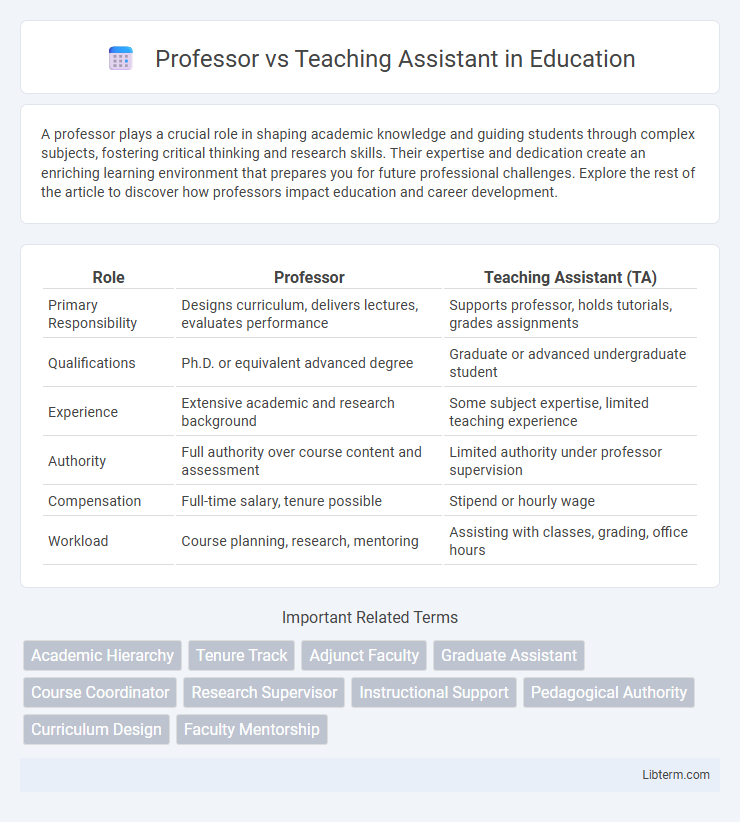A professor plays a crucial role in shaping academic knowledge and guiding students through complex subjects, fostering critical thinking and research skills. Their expertise and dedication create an enriching learning environment that prepares you for future professional challenges. Explore the rest of the article to discover how professors impact education and career development.
Table of Comparison
| Role | Professor | Teaching Assistant (TA) |
|---|---|---|
| Primary Responsibility | Designs curriculum, delivers lectures, evaluates performance | Supports professor, holds tutorials, grades assignments |
| Qualifications | Ph.D. or equivalent advanced degree | Graduate or advanced undergraduate student |
| Experience | Extensive academic and research background | Some subject expertise, limited teaching experience |
| Authority | Full authority over course content and assessment | Limited authority under professor supervision |
| Compensation | Full-time salary, tenure possible | Stipend or hourly wage |
| Workload | Course planning, research, mentoring | Assisting with classes, grading, office hours |
Roles and Responsibilities: Professor vs Teaching Assistant
Professors lead course design, deliver lectures, conduct research, and evaluate student performance, ensuring academic standards and subject mastery. Teaching Assistants support professors by grading assignments, conducting discussion sections, providing student assistance, and managing administrative tasks. Both roles collaborate to enhance the educational experience while maintaining clear distinctions in academic authority and responsibilities.
Educational Qualifications Required
Professors typically require a doctoral degree such as a Ph.D. in their academic field, demonstrating extensive research experience and subject mastery. Teaching assistants generally hold at least a bachelor's degree, often pursuing graduate studies, and possess foundational knowledge to support instructional activities. Higher educational qualifications for professors reflect their responsibilities in curriculum design, research, and academic leadership.
Core Duties in the Classroom
Professors design the curriculum, deliver lectures, and evaluate student performance to ensure academic standards are met. Teaching Assistants support classroom activities by facilitating discussions, grading assignments, and providing individualized help to students. Both roles collaborate to enhance the learning experience but differ in responsibility scope and decision-making authority.
Interaction with Students
Professors engage with students primarily through lectures, office hours, and research supervision, providing expertise and comprehensive guidance on complex subject matter. Teaching Assistants (TAs) facilitate more frequent, smaller group interactions, such as grading, leading discussions, and offering explanations that reinforce learning. The dynamic between professors and TAs presents a structured yet supportive educational environment, enhancing student understanding through varied levels of academic support.
Course Planning and Curriculum Design
Professors lead course planning by establishing learning objectives, selecting core materials, and designing the overall curriculum framework to align with academic standards. Teaching assistants support curriculum design by assisting in content development, creating supplementary materials, and providing insights based on student feedback. The collaborative effort between professors and teaching assistants enhances course coherence and improves the educational experience.
Grading and Assessment Duties
Professors hold primary responsibility for designing exams, creating rubrics, and determining final grades, ensuring academic standards and consistency. Teaching Assistants support grading by evaluating assignments, providing preliminary scores, and offering detailed feedback under the professor's guidance. Both roles collaborate to uphold assessment integrity while managing workload efficiently.
Research Expectations and Opportunities
Professors are primarily responsible for leading original research projects, securing funding through grants, and publishing findings in peer-reviewed journals, which establishes their academic reputation and contributes to their institution's prestige. Teaching Assistants (TAs) typically have limited research obligations, often assisting with data collection, literature reviews, or lab maintenance under the supervision of professors, providing them with valuable hands-on research experience. While professors have greater autonomy and opportunities to develop independent research agendas, TAs benefit from mentorship and collaboration that build foundational skills for future academic careers.
Workload and Time Commitment
Professors typically handle extensive workloads, including preparing lectures, conducting research, grading, and advising students, which demands a significant time commitment often exceeding 40 hours per week. Teaching Assistants primarily support professors by grading assignments, leading discussion sections, and assisting with administrative tasks, resulting in a more flexible but still time-intensive schedule usually ranging between 10 to 20 hours weekly. The substantial workload and time commitment for professors reflect their multifaceted role in both academic and research responsibilities, while Teaching Assistants focus primarily on instructional support.
Career Progression and Advancement
Professors typically hold doctoral degrees and pursue research, publication, and leadership roles, positioning themselves for tenure and academic promotion to associate or full professor ranks. Teaching Assistants, often graduate students or entry-level educators, gain instructional experience and subject mastery, serving as a stepping stone toward advanced graduate studies or academic careers. Career progression for professors involves securing grants and publishing scholarly work, while teaching assistants focus on developing teaching skills and deeper domain expertise.
Impact on Student Learning Experience
Professor-led instruction offers in-depth expertise and authoritative knowledge, creating a structured learning environment that drives academic rigor and critical thinking. Teaching Assistants provide personalized support and facilitate small group interactions, enhancing engagement and comprehension through more accessible mentorship. The combined roles of Professors and Teaching Assistants significantly enrich the student learning experience by balancing theoretical mastery with practical guidance.
Professor Infographic

 libterm.com
libterm.com